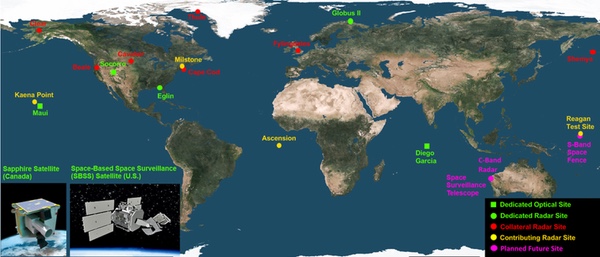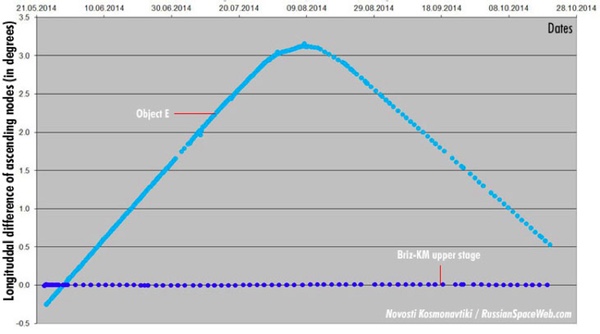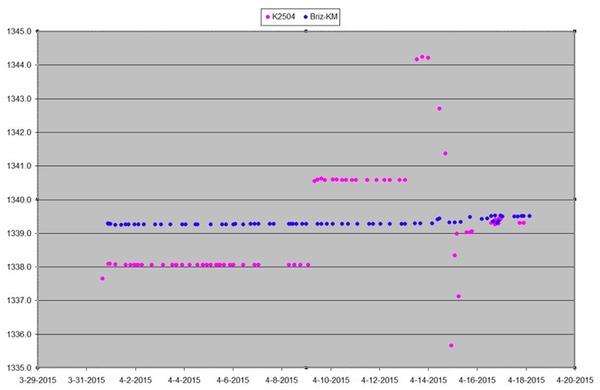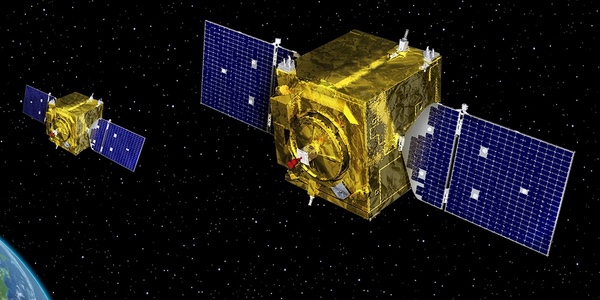Dancing in the dark redux: Recent Russian rendezvous and proximity operations in spaceby Brian Weeden
|
| These activities reinforce the need for more transparency on space activities to increase monitoring of RPO and similar dual-use capabilities, as well as the development of norms of behavior to help distinguish between peaceful space activities and hostile threats. |
Although China’s RPO activities in space are still a significant concern for the US national security space community, Russian activities have recently become more of a concern as well. Four Russian space launches in 2013 and 2014 in particular have sparked interest. Three of the launches placed small Russian military satellites into LEO; two of those satellites have conducted RPO activities with Russian rocket stages, and one appears to have “bumped” into the rocket stage near which it was maneuvering. The fourth launch was a Russian military satellite to geostationary Earth orbit (GSO). In the one year since its launch, the satellite has moved several times to different positions in the GSO belt of active satellites. Two of those stops were somewhat close to newly launched Russian satellites, and the third was between and very close to two Intelsat commercial communications satellites.
This article reviews the publicly available information on all four of these recent Russian launches, and attempts to shed some light on why these particular RPO activities have created concerns. It documents the timeline of what we know about the Russian RPO activities, drawing on open source analysis from the hobbyist satellite observer community, and compares the Russian RPO activities to similar American and Chinese RPO activities. It concludes that, as was the case with previous Chinese and American RPO activities, the Russian RPO activities appear to be aimed more at developing on-orbit inspection or intelligence capabilities than an ASAT weapons system, although the technology could be used for ASAT applications in the future. These activities reinforce the need for more transparency on space activities to increase monitoring of RPO and similar dual-use capabilities, as well as the development of norms of behavior to help distinguish between peaceful space activities and hostile threats.
The mysterious Objects E
On December 25, 2013, a Rockot space launch vehicle (SLV) launched from Plesetsk Cosmodrome in northwest Russia at 0:31 UTC on what appeared to be another routine launch to replenish the Rodnik constellation. The Rodnik satellites are the current generation of store-and-dump communications satellites, which store messages uploaded from end users and then downlink them when the satellite passes over a receiving station. The launch was publicly announced, and shortly afterwards the Russian Defense Ministry announced that the three spacecraft had successfully separated from the upper stage.
As they do with all space launches, the US military tracked the Rockot launch and began the process of detecting, tracking, and cataloging any new space objects. Within hours, analysts working in US Strategic Command’s (USSTRATCOM) Joint Space Operations Center (JSpOC) published the initial element sets for four objects on the Space Track website: 39483 (Object A), 39484 (Object B), 39485 (Object C), and 39486 (Object D), all in orbits of roughly 1510 by 1480 kilometers (938 by 919 miles). Six days later, on December 31, they cataloged a fifth piece from the launch, object 39497 (Object E). Neither the delay in cataloging the last piece nor the break in sequence is unusual. Satellite catalog numbers (satnos) are assigned sequentially from the first space object ever cataloged (which was actually the rocket body that placed Sputnik into orbit). Prior to a launch, the analyst will reserve as many Satnos as they expect to have objects from that launch, based on any pre-launch information and the historical pattern. It’s not unusual for an additional small piece or pieces of debris to be detected days after launch, by which time other objects may have been cataloged and taken up the next several satnos in sequence.
At this point, it is worth pausing to better understand the process by which all this takes place. The US military uses constellations of missile warning satellites to detect space launches. The launch time, azimuth, latitude, and longitude are used to queue the radar and optical sensors that make up the Space Surveillance Network (SSN) as to when any object placed into orbit from that launch might pass overhead. The sensors report back observations on any newly tracked objects from the launch, and the observations are collated to create an estimated orbital trajectory for each piece. Depending on the launch site and azimuth, this process may take anywhere from an hour to several hours for the newly launched objects to pass over tracking sites and enough observations to be collected. (For more details, see “The numbers game”, The Space Review, July 13, 2009.)
 US Space Surveillance Network. Source: Secure World Foundation |
In most cases, analysts performing this mission are operating like detectives trying to solve a mystery. They probably start out with some facts (clues), such as the expected launch date or information about the expected rocket or payload(s). They also have a previously established database of modus operandi (MO) for how certain activities have taken place in the past. For example, they may know that a certain number of launches featuring a specific booster and a specific payload have taken place in the past, and all of those launches have followed a certain sequence of events.
Regardless of how many or how few facts analysts have, when the actual event occurs they are operating under a model of “trust but verify.” The starting facts and MOs allow the analysts to make hypotheses about what might happen and help direct the process, but ultimately they are relying on the evidence, in the form of tracking data from the SSN and other sources of data, to confirm or repudiate their hypotheses.
| In the case of space situational awareness (SSA), these data problems have historically been dealt with using a closed data model. This type of trust model has both advantages and disadvantages. |
It’s also important to keep in mind the data types and sources these analysts have at their disposal. As is the case with most things, it is a far cry from the Hollywood version. In most fictional scenarios, data are most often used to drive the plot forward. The protagonists usually don’t have to worry about mundane things like whether or not the data are real, incomplete, or what they actually mean. In the real world, all of these are major problems that need to be dealt with.
In the case of space situational awareness (SSA), these data problems have historically been dealt with using a closed data model. Only data from specific, trusted sources is allowed into the system, and only after each of those sources has been individually tested and validated to perform to a specific level of accuracy and precision. The data are all passed to a central hub, where it is collated and analyzed by both human experts and software algorithms, who themselves are specially trained, or designed, and selected for trust.
This type of trust model has both advantages and disadvantages. On the plus side, it ensures a high degree of reliability in the performance of the system to accomplish the task it was created to do. On the negative side, it makes the system rigid and expensive. The system has difficulty adapting to change, incorporating new types of data or data from new sources, and adding capacity to deal with increased workload. When you add in a massive, complex bureaucracy, such as the US Department of Defense, all of those negatives get reinforced. Budgets and acquisitions need to be planned many years in advance, and go through multiple iterations and levels of approval. Personnel are constantly cycling through, with each new batch having only a very brief period of time to learn the job and becoming “experts” before moving on to the next assignment.
Labeling the new space objects from the Rockot launch as Object A, Object B, etc. is a direct result of these challenges. The analysts working at JSpOC tasked with identifying each of the newly launched objects are doing so with data, software, and organizational concepts that were designed for a different era. The main source of data are what are known as metric observations—strings of numbers that indicate the position of a space object relative to a sensor. To the analyst, these observations appear as dots on a screen, and when enough of them have been collected, a mathematical process is used to estimate an orbital trajectory for the object. The computer software and hardware doing so are in some cases decades old.
What the metric observations do not provide is the additional information necessary to determine which of those space objects is which: the payload(s), the rocket body, or any pieces of debris. For that, additional information about the size, shape, and other characteristics of each of the space objects is needed. The data to provide that information certainly exist, but there are significant technical and bureaucratic challenges in getting them to the analysts. The data may come from sensors or sources that are outside the traditional closed trust network, and thus difficult to route to the analysts. The sensors and sources might need to be told first which object is which in order to provide their additional data, creating a Catch-22. The data may fall under a different chain of command, or a separate government organization entirely, which may be using them for a different purpose and reluctant to share them.
As a result, the established procedure at the JSpOC for the last several years has been to catalog any newly-launched objects with a label of Object A, Object B, Object C, etc. At some point in the future, after additional metric and other types of data are collected and analyzed, a determination is made as to which object corresponds to the payload(s), rocket body, and any pieces of debris from the launch. The objects are then re-labeled with their correct names and types, and enter into normal catalog maintenance.
In the case of the Rockot launch from December 2013, the re-labeling in the Space Track catalog was not made until somewhere between January 10 and January 12, 2014. By January 12, the public satellite catalog was updated to show satnos 39483 (Cosmos 2488), 39484 (Cosmos 2489), 39485 (Cosmos 2490), and 39486 (Briz-KM R/B), corresponding to the three Rodnik satellites and the Briz-KM upper stage (rocket body). The name “Cosmos” is the cover name for Russian military satellites where the actual designation is not publicly revealed (similar to the American use of the “USA” designator). Satno 39497 was still labeled Object E at that point, and it was not until January 30, 2014, that it was renamed as Briz-KM debris. This is not unusual, as the focus was likely on identifying the payloads.
| Satno | Original Name | Date Cataloged | Final Name | Date Updated |
|---|---|---|---|---|
| 39483 | Object A | 12/25/2014 | Cosmos 2488 | 1/12/2014 |
| 39484 | Object B | 12/25/2014 | Cosmos 2489 | 1/12/2014 |
| 39485 | Object C | 12/25/2014 | Cosmos 2490 | 1/12/2014 |
| 39486 | Object D | 12/25/2014 | Briz-KM R/B | 1/12/2014 |
| 39497 | Object E | 12/31/2014 | Cosmos 2491 | 8/4/2014 |
Four out of the five objects from the December 2013 launch maneuvered to change their orbits shortly after launch. In early January, the Briz-KM upper stage conducted a burn to lower its perigee to roughly 1140 kilometers (708 miles) in order to comply with the 25-year rule in the Inter-Agency Space Debris Coordination Committee (IADC) space debris mitigation guidelines. Throughout January and into March, the three Ronik payloads (Cosmos 2488, 2489, and 2490) made some minor maneuvers to establish their operational orbits and positions. By all accounts this was normal and expected behavior.
The first public hints that something may be out of the ordinary occurred on a Russian-language message forum for the Novosti Kosmonavtiki magazine, a popular gathering place for people interested in observing and tracking satellites. On May 6, 2014, a user reported that the Russian government announcement regarding that day’s launch of a new Russian Kolbalt-M spy satellite indicated a discrepancy in the Cosmos numbering system. The spy satellite was assigned the cover name Cosmos 2495, instead of the expected 2492. The suspicion was that this was either a mistake, or a clue that there were three “missing” Russian military satellites that had yet to be publicly acknowledged.
| Although both objects were launched into the same inclination, they had different right ascensions in ascending nodes (RAAN) due to being at different altitudes. Lowering Object E’s orbit changed the gravitational perturbation on its RAAN in a way that would bring it to match Briz-KM’s RAAN by early November. |
On May 17, Jonathan McDowell’s Space Report newsletter added more information. He noted that Bob Christy at Zarya.info had discovered an “unreleased” United Nations registration filing from Russia that indicated the December 2014 Rodnik launch had a fourth payload on board, which was designated by the Russian government as Cosmos 2491. McDowell speculated that it corresponded to satno 39497 (Object E from the December 2013 Rockot launch), which was still labeled as Briz-KM debris in the public satellite catalog. McDowell also speculated that Cosmos 2491 may be related to two previous Strela launches that included small satellites based on the Yubilyeniy-2 experimental platform that was co-developed by a Russian company and university.
On May 23, 2014, another Rockot launch took place from Plesetsk at 05:27 UTC with what appeared to be another Rodnik replenishment mission. Once again, the Russian government publicly declared that the launch carried three military satellites. Within a few hours, the JSpOC had cataloged four pieces from the launch—satnos 39761 (Object A), 39762 (Object B), 39764 (Object C), 39764 (Object D)—and again all in orbits of roughly 1510 by 1480 kilometers (938 by 919 miles). A fifth piece, Satno 39765 (Object E), was added several hours later. Again, this is not unusual. The close sequencing of satnos indicates that the analysts learned from the December 2013 launch and updated the MO for a Strela launch to indicate that there may be an additional space object. The likely reason for why it took several hours longer to get enough tracking data to catalog the fifth piece was because it was much smaller and closer to the rocket body, making tracking challenging.
Two days later, another hobbyist satellite observer, Rui Barbosa, reported on his website that he had received information that a fourth payload was on the launch. A discussion on NASA Spaceflight Forum noted that this was similar to the launch from December 2013, and that this fourth payload would likely be assigned the label Cosmos 2499. The US military’s public satellite catalog had not yet been updated by this point, and satno 39497 was still listed as a piece of Briz-KM debris.
Over the course of the next couple of weeks, the three Rodnik payloads conducted minor orbital maneuvers to refine their operational orbits, and the Briz-KM conducted a perigee-lowering maneuver to comply with the 25-year rule. The first four pieces (Objects A through D) were also relabeled on May 29 as Cosmos 2496, Cosmos 2497, Cosmos 2498, and Briz-KM R/B, to correspond to the three Rodnik satellites and the Briz upper stage. At this time, satno 39765 was still labeled Object E.
By mid-June, hobbyist satellite observers started reporting that satno 39765 (Object E) had begun maneuvering to match orbits with the Briz-KM rocket body (satno 39764) that placed it in orbit. It made a series of small changes to its orbit over a period of several weeks. The first change was to lower its apogee and perigee. This not only “sped up” how fast it orbited around Earth relative to the Briz-KM rocket body, but also initiated an orbital perturbation that slowly brought their orbital planes into alignment. Although both objects were launched into the same inclination, they had different right ascensions in ascending nodes (RAAN) due to being at different altitudes. Lowering Object E’s orbit changed the gravitational perturbation on its RAAN in a way that would bring it to match Briz-KM’s RAAN by early November.
 Comparison of RAAN between Object E and the Briz-KM upper stage. Credit Novosti Kosmonavtiki and RussianSpaceWeb.com |
During this period of time, the JSpOC began updating the names in the public catalog for the Object Es. By August 4, satno 39497 (what as originally Object E from the December 2013 Rodnik launch) was relabeled as Cosmos 2491, and had its status changed from a piece of space debris to a payload. Curiously, Satno 39765 (what was originally Object E from the May 2014 Rodnik launch) was relabeled as Briz-KM Debris by September 30, despite it having maneuvered several times and obviously being an active satellite. Two days later, its name was changed back to Object E, and it remained as such until it was changed on October 22 to Cosmos 2499. Interestingly, the United Nations registration database indicated that Russia registered Cosmos 2499 as an active satellite on August 12, well before it was updated as such in the public US satellite catalog.
| Satno | Original Name | Date Cataloged | Final Name | Date Updated |
|---|---|---|---|---|
| 39761 | Object A | 5/23/2014 | Cosmos 2496 | 5/29/2014 |
| 39762 | Object B | 5/23/2014 | Cosmos 2497 | 5/29/2014 |
| 39763 | Object C | 5/23/2014 | Cosmso 2498 | 5/29/2014 |
| 39764 | Object D | 5/23/2014 | Briz-KM R/B | 5/29/2014 |
| 39765 | Object E | 5/23/2014 | Cosmos 2499 | 10/22/2014 |
Towards the end of October, Cosmos 2499 began to change its orbit again, raising its perigee and apogee to match that of the Briz-KM rocket body. Somewhere around November 9 or 10, the two orbits synchronized as predicted. Both objects were now orbiting the Earth in very similar orbits, separated by a few to tens of kilometers. Observers calculated that they had reached their closest point around November 25 as Cosmos 2499 passed “under” the Briz-KM at a distance of around 600 meters. However, it is difficult to tell how accurate that estimate is, as there are known errors of several hundred meters or more in the publicly available trajectory information from the US military.
| Between April 15 and 16, Cosmos 2504 went from an estimated 4.4 kilometers above to 1.4 kilometers below the Briz-KM. At some point during that pass, the Briz-KM’s orbit was disturbed by an unknown perturbation, which could have been the result of a minor collision between the two space objects. |
In late November, there were public indications that Cosmos 2499 was broadcasting radio signals. The first report was from Dmitry Pashkov, a Russian amateur radio enthusiast, who picked up Cosmos 2499 broadcasting telemetry under the call sign RS-47 in Morse code on the UHF frequencies of 435.57 and 435.6 megahertz. In early December, a discussion thread on the Hearsat mailing list (used by enthusiasts who track radio signals from satellites) added that Cosmos 2499 also had an S-Band downlink centered on 2280 megahertz that turned on as the satellite came into view from Moscow. A Dutch member of the list, Cees Bassa, announced that he had detected an S-band signal from Cosmos-2491 during a pass over Europe on the same frequency as that used by Cosmos 2499, and Pashkov confirmed that Cosmos 2491 was also using the same UHF downlink. This also corresponds to the known frequencies used by the Yubileiny-2 microsatellites.
The slow maneuvering of Cosmos 2499 continued into early 2015. After their closest approach at the end of November, Cosmos 2499 and the Briz-KM rocket body began to drift apart to a distance of tens of kilometers. In January 2015, Cosmos 2499 began to slowly close on the Briz-KM again. Towards the end of January, the two orbits were within a few kilometers in altitude, although the objects were still separated (laterally) by a few hundred kilometers. Cosmos 2499 was at one point behind and then at another point in front of the Briz-KM, relative to the Earth, indicating proximity operations. Note that both were still orbiting the Earth, but their orbits were aligned such at from an observer on the Earth Cosmos 2499 appeared to be orbiting “around” the Briz-KM.
On March 31, 2015, yet another Rockot launch took place from Plesetsk at 11:47 UTC with what was publicly declared as carrying three Gonets-M satellites and a classified military payload. The Gonets serves as a civilian version of the Strela/Rodnik store-and-dump LEO communications constellation. Although Russian officials did not elaborate on the nature of the fourth payload, observers assumed it was yet another of the same small satellites as on the December 2013 and March 2014 launches.
As usual, the US military tracked the launch and began to catalog new space objects within a few hours of launch. The pattern was the same as with the May 2014 launch: five catalog numbers were reserved (40552 through 40556) and labeled as Objects A through E. Objects A through C, believed to be the Gonets satellites, were all in orbits of roughly 1507 by 1500 kilometers (935 by 932 miles). Objects D and E, believed to be the Briz-KM upper stage and the fourth payload, were in orbits of 1507 by 1172 kilometers (935 by 728 miles). This indicated that the fourth payload had separated from the Briz-KM upper stage after it had performed its perigee-lowering disposal maneuver, which was a distinct difference from the deployment of Cosmos 2491 and Cosmos 2499 during their respective launches. Observers immediately suspected that satno 40555 (Object D) was the fourth payload, and assigned it the cover name of Cosmos 2504. Supporting this conclusion was the fact that it was detected broadcasting on the same frequencies as Cosmos 2491 and Cosmos 2499.
Cosmos 2504 began maneuvering shortly after launch. The first maneuver was detected on April 9, followed by a few more small maneuvers over the next week to bring it closer to the Briz-KM rocket body. Between April 15 and 16, Cosmos 2504 went from an estimated 4.4 kilometers above to 1.4 kilometers below the Briz-KM. At some point during that pass, the Briz-KM’s orbit was disturbed by an unknown perturbation, which could have been the result of a minor collision between the two space objects. If it was, the impact was very slight and did not result in additional debris being generated. It is also unknown if the impact was planned or was an accident.
 Relative mean motion of Cosmos 2504 and the Briz-KM upper stage that placed it in orbit.
Image credit Novosti Kosmonavtiki Magazine Forum. |
Between April 26 and 28, the JSpOC relabeled the objects from the launch as satnos 40552 (Gonets M-11), 40553 (Gonets M 12), 40554 (Gonets M 13), 40555 (Cosmos 2504), and 40556 (Briz-KM R/B).
| Satno | Original Name | Date Cataloged | Final Name | Date Updated |
|---|---|---|---|---|
| 40552 | Object A | 3/31/2015 | Cosmos 2501 | 4/28/2015 |
| 40553 | Object B | 3/31/2015 | Cosmos 2502 | 4/28/2015 |
| 40554 | Object C | 3/31/2015 | Cosmos 2503 | 4/28/2015 |
| 40555 | Object D | 3/31/2015 | Cosmos 2504 | 4/28/2015 |
| 40556 | Object E | 3/31/2015 | Briz-KM R/B | 4/28/2015 |
On July 3, 2015, Cosmos 2504 made another significant maneuver, lowering both its apogee and perigee significantly by around 50 kilometers each, further separating itself from the Briz-M. Since July, it has not conducted any significant maneuvers. The Briz-M orbit has remained unperturbed since the apparent bump through September 2015.
